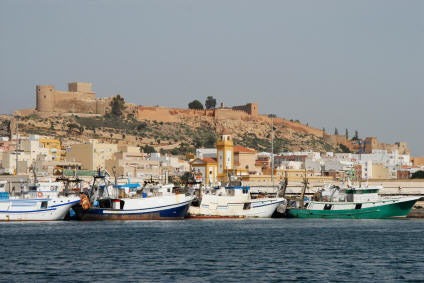 Almeria is set within a desert-like landscape which is a feature of this part of Andalucia. The city of Almeria reached its peak about 1,000 years ago when it was an important Moorish port and centre of learning.
Almeria is set within a desert-like landscape which is a feature of this part of Andalucia. The city of Almeria reached its peak about 1,000 years ago when it was an important Moorish port and centre of learning.
Although Almeria fell into decline after a series of damaging earthquakes during the 12th century, Almeria has undergone something of a resurgence in recent years, helped by the influx of money earned from agriculture. The hosting of the 2005 Mediterranean Games in Almeria has also helped to put the city back on the map. Today Almeria has a relaxed atmosphere, despite the heavy traffic.
The old town district of Almeria, which is bordered by the port, Rambla de Belen and the Alcazaba, provides the biggest draw for visitors. Attractions in this area include the 16th century cathedral, which occupies the site of a former mosque. When the cathedral was being built, Almeria was often under attack by the Moriscos, hence the strong fortifications which have been incorporated into the building's design.
Inside the cathedral is Murillo's painting, Immaculate Conception, and several other fine artworks. To the east of the cathedral is the Casa de los Puche, the oldest house in Almeria dating back to the 18th century, while to the north of Almeria is a memorial dedicated to a group of liberals who were executed here in 1831. Other notable sights in the old town include the Olive Oil Museum and church of Santiago, built in the mid-sixteenth century.
The biggest and most dominant tourist attraction in Almeria is the hilltop Alcazaba, surrounded by walls measuring nearly a mile in length. This fine example of Moorish military architecture was first built in the late 10th century under the orders of the Caliph of Cordoba, but later expanded by the Catholic monarchs Ferdinand and Isabella after they had recaptured the city in 1489. There are a couple of interesting circular towers within the Christian section of this gigantic fortress; the Tower of Homage in Almeria castle contains a photography exhibition, and there are some superb views from the Gunpowder Tower towards the city's cave dwellings in the district of Barrio de la Chanca, Almeria.
Almeria is not particularly well-known for its nightlife, with most of the decent nightclubs in Almeria situated in the resorts to the west of Almeria. It is however renowned for its tapas bars, many of which are concentrated around the Paseo de Almeria. Specialities include Gachas (clam stew), Escabeche e Sardines (sardines in a hot sauce) and Trigo (a stew containing pork and wheat grains).
The Almeria train station is situated at Plaza de la Estacion, about 1km from the city centre. There are direct train services from here to Seville and Granada. For Malaga and Cordoba, you need to change at Bobadilla. To the north of the railway station is the main Almeria bus station, served by several companies including Alsina Graells, who operate services to Malaga, Granada, Seville, as well as some local routes. Almeria has an international airport, around 6 miles (10km) from the city centre. There are regular bus services to the airport from calle Doctor Gregorio Maranon to the north-east of the city centre.